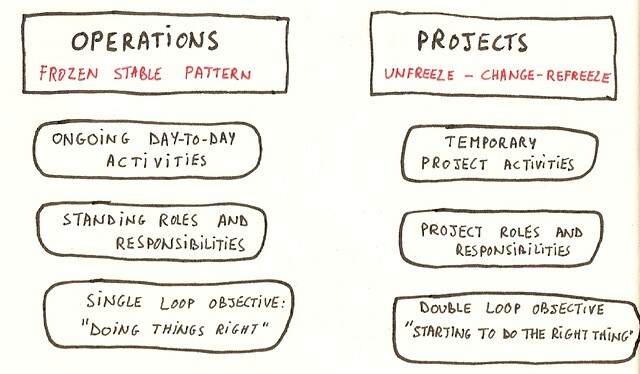Are you ready to integrate Social Architecture into your projects? Here are some insights that will help you to stay on the right track.
How do we bring the philosophy of Social Architecture into being? Although there are some rare examples of companies that function with the lattice of a social architecture by default; to the other 99% of companies the idea is new. And in organizations new things don’t just flip like a switch. The primary goal of any organization is to preserve its operating architecture.
The best shot we have at bringing Social Architecture into being is through the vehicle of projects and programs. They can bring an organization from one state of being into the next. An important characteristic about projects is that they start at the edge of the organizational jungle. I am explicitly using the word ‘jungle’ here, because the latest insights on biodiversity show that new species never start in the middle of a forest. Rather, they come into being where two ecosystems meet.
But even in the context of projects, the introduction of Social Architecture can never be the primary goal of a project. Social Architecture is the fabric of the context, not the raw material of the product. This means that we should aim for small initiatives, below-the-radar actions and out-of-pocket-money funded hacks. Launching a strategic initiative with the intent to transform an organization into a social architecture is as dangerous as dropping a new species in the middle of an ecosystem. It’s a matter of counting the hours for it to be eaten alive. Big bang? Not a good idea.
But if not big bang, then what? Micro-biology delivers the answer. There are three parts of our projects that can be determined by choosing the setup of a social architecture. They are:
- The cell-structure of our project. The way we design a project needs to be infused with the philosophy. In fact, this is the cornerstone that determines all the rest. Examples of project design include design principles that can easily be linked to characteristics of ecosystems:
- Diversity of the project team: making sure that the team is composed of members that represent different parts of the organization.
- Connection and synchronization with the organization: making sure that the plan and the budget include ‘moments of truth’. These are events where the project team and the organization do reality checks of different parts of the project. This should happen at every stage of the life-cycle.
- Infection and incubation. Each time a part of the project is delivered, we need to make sure that the people involved are not only informed and trained, but that they are also made responsible for the maintenance and the further development. As it is the case with an infection, this means that we need to allow an incubation period.
- That’s why it is important to appoint ‘business representatives‘ and support roles for the project well in advance.
- Also, we should start the battle for the time and attention of business representatives early enough. The battle with the hierarchical responsibles of the business representatives is part of the intrusion that is necessary for the infection to ignite.
- Last but not least, the infection will only work when we assign the business representatives vital tasks that are on the critical path of the project. This creates a sense of purpose that will breed ownership of every individual, and in the long run of the entire organization (hence the metaphor of an incubation period).
- Mitosis, i.e. the mirroring the project structure on the inside of the organism. This certainly goes for long term projects with multiple roll-outs.
- Make sure that the organization sets up a dedicated team that learns to do roll-outs without the help of an external project team.
- Also, we need to make sure that this team creates some authority within the organization. This is another battle against rejection that occurs below the radar.
From a project management perspective these three elements will be considered side matters as they occur for the largest part below the radar; and that’s a good thing, because we don’t want the big spotlights on a fragile structure. Therefore, there is one last thing you should know about Social Architecture. It’s the real secret of a successful implementation: it’s all about attitude; an insight that occurs on the micro-biological level; i.e.: the behavior and that of the project team. It’s our humble attitude and paying attention to relationship management (with a purpose, that is) which lie at the heart of a successful implementation of Social Architecture.
Oh, and by the way: avoid using the word too much. We want it to become engrained as a habit and not a short-lived like a hype.


